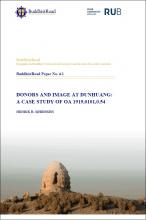BuddhistRoad Paper 4.1. "Donors and Image in Dunhuang: A Case Study of OA 1919,0101,0.54"
Synopsis
This essay explores a case of a religious painting in Dunhuang, an icon of the Bodhisattva Avalokiteśvara (OA 1919,0101,0.54), offered as a joint, multi-generational family enterprise. During the 9th and 10th centuries, we see that donor-portraits became increasingly important as fixtures in votive paintings produced in Dunhuang, in some cases even surpassing the importance of the main icon itself. Not only was it the living who sought to create religious merit for themselves and their deceased relatives, but in many paintings the dead were still very much ‘active,’ or at least present.
Chinese Translation
本文探讨了敦煌宗教壁画中的一个案例, 即被某一家族历代集资供养的觀(世)音菩萨像 (OA 1919,0101,0.54). 在9–10世纪, 可以看到供养人肖像的绘制在敦煌祈愿壁画中渐成惯例且越来越重要, 在某些情况下甚至超过了主供像本身. 这不仅是生者要为自己和已故的亲属积累功德, 在许多壁画中, 死者仍然非常 “活跃”, 或至少维持在场的状态.

Downloads
Published
Categories
License

This work is licensed under a Creative Commons Attribution-NonCommercial-NoDerivatives 4.0 International License.

